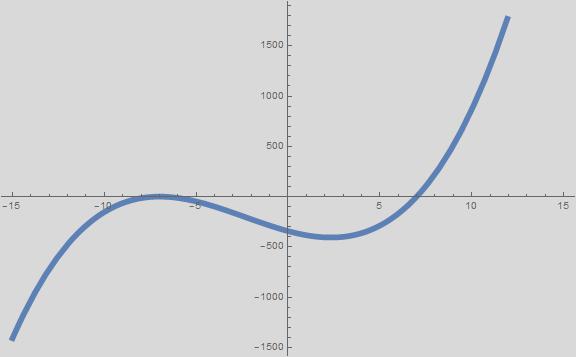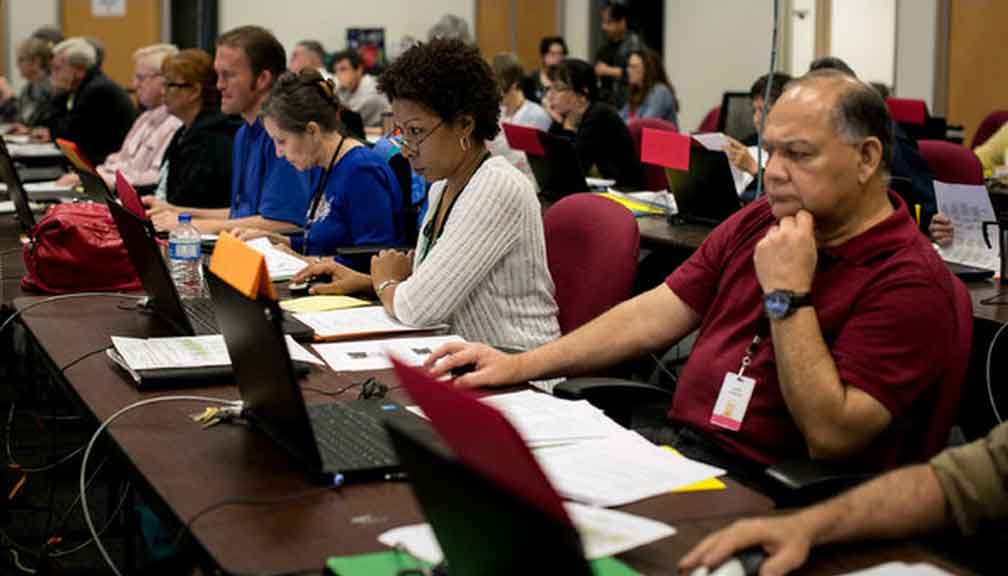The following drag-and-drop question, explained here in hopes of helping algebra 1 students and their parents in Maryland and Illinois prepare for the PARCC test near the end of this school year, appears on the released version of PARCC’s Spring 2016 test for algebra 1 (#2):

Determine all real roots of the equation
Drag and drop all real zeros of the equation into the box.
(The question format makes you drag integers into a receiving bay. You can drag as many as you want into the bay. The choices are 0, +/–3, +/–4, +/–7, +/–14, +/–49.)
Analysis of this question and online accessibility
The question is valid in that it partially tests students’ ability, given an appropriate factorization of a polynomial, to identify the zeros of that polynomial. On an actual test, other problems would be required to test the complete standard, as found in the Common Core, but this problem is a valid test of part of that standard.
Guessing is possible, given that students taking the test could plug in each value and see if it works. Our sample solution strategy includes a test for each correct answer, showing how elementary the arithmetic is to perform the “guess and check.” However, plugging each value into the polynomial is an approach that includes the construct being assessed, and the validity of the question is not in jeopardy.
Drag-and-drop questions like this can be delivered online or on paper, but the paper version of this item would be presented in a multiple-select format, where students would darken the ovals for two of the seven (or nine) possible zeros presented. Still, the reliability, validity, and fairness performance should be be the same, regardless of the delivery mode.
No special accommodation challenges can be identified with this question, so the question is considered fair.
The question misses the mark on the standards for mathematical practice it purports to measure (MP.3). This practice, which is considered overarching in the Common Core, says students should be able to “construct viable arguments and critique the reasoning of others.” There is no argument required on this question, and the question itself, therefore, fails to align to the spirit of the math practice it purports to test.
Students never need during the solution process to “justify their conclusions, communicate them to others, [or] respond to the arguments of others,” as specified in the math practice. They do, however, have to “reason inductively about data” in identifying the zeros from an appropriate factorization. In order to assess the math practice, though, students should have to make “plausible arguments that take into account the context from which the data arose,” not just identify the conclusion of those arguments.
To be fair, including this math practice may be less likely on a multiple-choice-like question than it would be on a written response. The limits of large-scale testing—specifically, cost to the state—preclude using constructed response questions for everything, but here, we sacrifice our ability to test the math practice we claim to be assessing.
Resources for further study
Purple Math, developed by Elizabeth Stapel, a math teacher from the St Louis area, has a series of web pages dedicated to understanding polynomials, their graphs, and their zeros, including one entitled “Zeros and Their Multiplicity,” which explains how we got only two zeros to a third-order polynomial in this problem. Her web pages begin with 1 of 5 here.
The Khan Academy, developed by Sal Khan, an engineer who has created a library of thousands of video lessons, has a series of video tutorials that teach students how to find zeros of polynomials and graph those polynomials by using the zeros. The series begins here.
Ron Larson, Laurie Boswell, Timothy D Kanold, Lee Stiff. Algebra 2, Illinois edition. Evanston, Ill.: McDougal Littell, a division of Houghton Mifflin Company, 2008. The book is used in several algebra classes taught in Illinois high schools. See especially Section 5.2, entitled “End Behavior of Polynomial Functions.”
Purpose of this series
To help algebra 1 students and their parents prepare for the PARCC test in math, as administered in at least six states, or to just master content on that test, we provide an analysis of every algebra 1 math problem PARCC released in 2016. The series can be found here.















